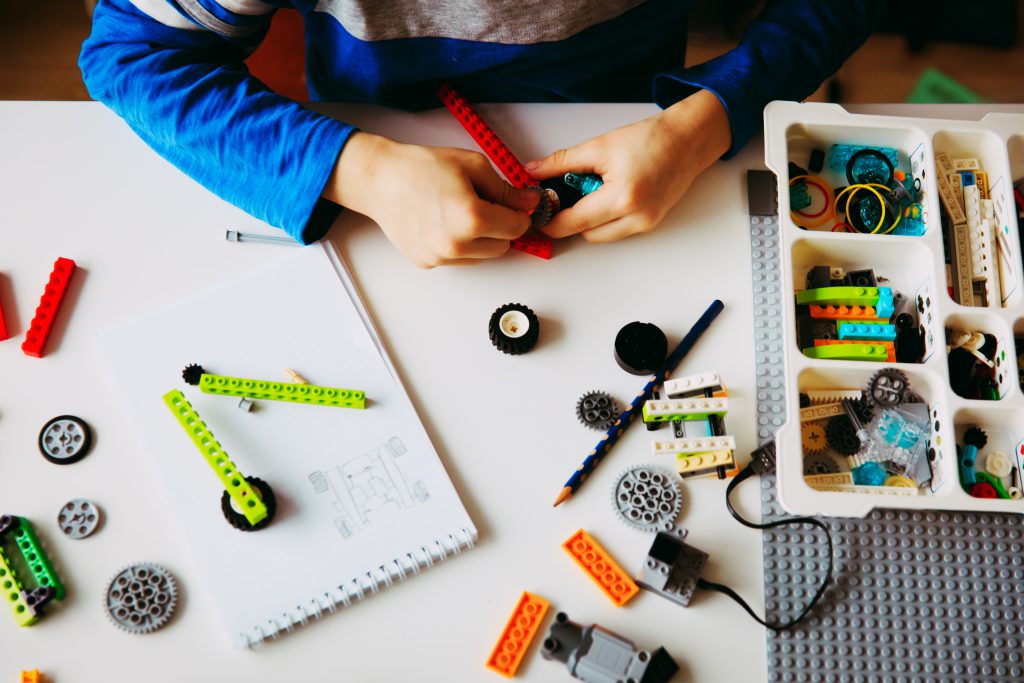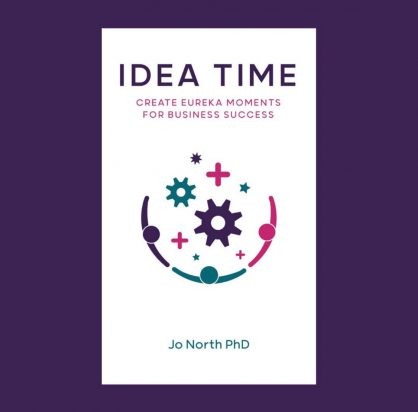Posted in Blog, Boost Your Brainpower, Create by Jo North
What is an idea?
This article is all about you and your ideas. An idea is when two thoughts connect. Having an idea is a physical activity. It is chemical and electrical. Sometimes we think we are having a moment of insight that comes from nowhere, but actually our mind and our creative subconscious have been working on it in the background. It is only when it becomes apparent that a connection is made, that the background work surfaces to create an idea.

Ideas are a result of everything going on in your head. They are a result of your experience, sights, sounds, smells and much more. The world around you stimulates you to have ideas, but the ideas can only originate from inside your mind.
In this article, I share science-based insights on how ideas happen and give you some practical, fun tips on how you can become even more creative! There’s a great activity for you try – check out my video here, too. And read to the end of the article for a special, free bonus – all you need to do is send me an email to get it.
Have you ever ‘felt’ an idea?
Sometimes, when you have an idea you can feel it! It literally does feel like the lightbulb moment, the exclamation mark popping up over your head, doesn’t it?
This is the feeling of those connections are being made. It is neural activity. So, the more new and good stuff you put into your head, the better stuff you get out. Steve Jobs famously said that connectivity is really important for creativity, because creativity is just about connecting things.
As Einstein wrote:
“We can’t solve problems by using the same kind of thinking we used when we created them.”
That’s why understanding how we can have more, and better ideas is a fantastic superpower that we can all learn and benefit from.
In terms of being innovative, ideas are at the heart of innovation. This is obvious, but sometimes we start to think of innovation without understanding ideas, and how our minds work, and if we know how our minds work, then we can innovate better. Ideas are the creative bit that go into the innovation process.

What is the definition of innovation?
When I ask people to define innovation for me, they say things like:
“Getting an idea and making it a reality.”
“Thinking outside the box.”
“Thinking about how to get round problems.”
Innovation is purposeful. Innovation is taking an idea and making it useful. It is the process of having that idea in the first place, and developing that idea, so that it becomes something you can do something with.
Sometimes creativity doesn’t have to have a purpose. You can be creative for creativity’s sake. What we are doing with innovation is turning that creativity into something.
When do you have your best ideas?
Think about the times when you have your best ideas. When I ask people in workshops when they have their best ideas, they say things like:
“In the morning.”
“When you are talking to people and they say something that triggers something and you get an idea.”
“In the middle of the night. I have to write it down or it will be gone in the morning!”
“At the coffee shop.”

We have our best ideas when we are not deliberately focused on something, when our logical, analytical thinking isn’t activated and we can access the work that our creative subconscious has been doing, unbeknown to us, while we have been busy doing other things. Usually the best way to have ideas is to articulate the problem, opportunity or challenge, take in any data or information you need and then forget about it and do something else. This could be another task, exercising or sleeping. Your creative subconscious will do the work for you while you’re focusing on something else.
Ideas are a numbers game
Ideas are also a numbers game. I want to encourage you to have as many ideas as possible, without worrying about how good they are. One of the reasons is because you can get a number of ideas and combine or connect them to create more ideas.
Case study: Combining ideas to create frog robots!
I was fascinated to read in BBC’s Science Focus magazine that a team of scientists based at Tuft’s University and the University of Vermont have successfully turned stem cells taken from frog embryos into living robots, using computer algorithms! They’ve literally combined living cells with robotic functionality. And by using some cells from the heart, the frog-cell robot, which they have called a ‘xenobot’, moves itself, because the heart cells are pre-conditioned to ‘beat’. The research co-leader Professor Joshua Bongard, describes the ‘xenobots’:
“These are novel living machines…They’re neither a traditional robot nor a known species of animal. It’s a new class of artefact: a living, programmable organism.”
Professor Joshua Bongard
Potential uses for the ‘xenobots’ include cleaning up pollution in the sea, or targeted drug delivery systems, but there is much more work to do and of course an ethical practice does need to be developed.

Idea stretch
To get to great ideas that aren’t immediately obvious and predictable, you have to have a lot of ideas and get the obvious ones out of the way, so that you can come up with something that is a bit more original. Having lots of ideas clears your head, so that you can then go for more stretch and get to more novel and original ideas.
Idea proliferation
All of this is a process, so if you have two ideas A and B, taking into account those connections I was talking about earlier, you can only get one new idea from those, AB.
If you have got three ideas A, B and C, then you can get four new ideas AB, AC, BC & ABC, by putting them together.
McDonalds put together food manufacturing processes and the idea of a restaurant to create fast food. Apple put together the camera, the e-mail, health device and much more to create what we know as the i-Phone.
If you have for ideas A, B, C & D you have eleven potential new ideas. And you can keep going… seven ideas can generate 120 new ideas. This is where the magic happens, at that intersection. If you put one idea together with another, what happens? You can actually get some really interesting innovation happening – as well as a lot of unhelpful or unusable ideas too! But that’s part of the process. To get a truly great idea you often need to have lots of less great ideas first.

Premature evaluation kills creativity
Let’s work this through. If you have an idea but dismiss it and don’t vocalise it, it may mean that somebody else isn’t stimulated by that idea and have the opportunity to take it somewhere else.
We have our obvious ideas first. We have to clear our minds to get to other ideas.
And, the fact that you use different modes of thinking to do different processes means that if you try to critique your ideas at the same time as you’re having them, you will get in your own way. It’s like trying to get up to the fastest speed you can on a completely straight stretch of motorway, but braking as soon as you’ve accelerated. By evaluating your ideas too soon, you’re getting in your own way.
Premature evaluation kills creativity.
Your lazy brain
Your brain, for very good reasons, is very lazy. It takes the path of least resistance. Because your brain is a big consumer of glucose, the more shortcuts you have, the less energy your brain consumes. And your brain wants to keep you safe, and not do anything that is going to jeopardise you. It likes you to do things it knows you have done before, and keep you in that place, because it didn’t kill you the last time you did it.
To have new ideas, it’s really helpful to nudge your brain out of taking those shortcuts and make it go the long way round, to come up with something different.
Did you know that your brain is plastic? You can create new neural pathways., or ways of thinking. The more you think a certain way the more engrained you become in that way of thinking, and the harder it is to get out of it.

Using idea generation techniques
Idea generation techniques work by making your brain think differently from how it does usually. If you always think as you have always thought, you will always think what you’ve always thought of. You can develop your creative thinking ability. And if you don’t use part of your brain, we know it dies, because why would you maintain something you are not using? But you can also grow it, and you can grow it at any age.
Here is a fun activity that we know for sure will develop the creative functioning of your brain by helping you to get faster, more agile and skilled at making new connections to come up with new ideas.
Alternative uses activity
This activity is based on Guilford’s Alternative Uses Task (1967).
- Take an everyday object, such as a spoon.
- Grab a pen and paper.
- Set your timer for 2 minutes.
- Write down as many alternative uses for a spoon as possible.
- When the three minutes are up, count your score. The higher the number, the greater creative fluency you have shown.

If you want to really get into it, as well as the number of ideas that you come up with, you could also review the following:
- Originality – have you come up with anything you think is unusual or original?
- Flexibility – are your ideas on a similar theme (for example, for the paperclip you may have written earring, ring, pendant – these all have the shared theme of jewellery). If your ideas are across different themes, you’re showing greater flexibility.
- Elaboration– the amount of detail you’ve given (for example, an ‘art instrument’ has little detail, but an ‘art instrument for making lines in oil paint’ has more).
Practise this regularly with different, random objects, and aim to increase your score every time. I’ve seen my MSc Engineering Management students go from 14 items in 2 minutes up to 44 items over 8 weeks, simply by practising once or twice a week. This does wonders for your everyday idea generation because you start to see links between items more readily.
You can also use this activity as a quick, creative warm-up if you’re facilitating group sessions.
A free bonus item from me
I hope you’ve enjoyed these insights into ideas. If you’d like to learn how to create even more eureka moments for business success, check out my book, Idea Time – Creative Thinking for Entrepreneurs. And if you email me at jo@ideatime.co.uk to let me know that you’ve read this article, I will send you a free bonus item to help you to develop your creative potential.


